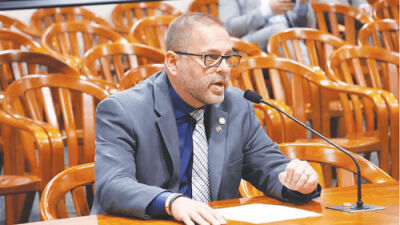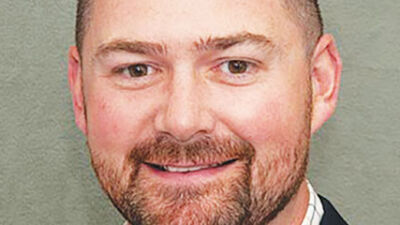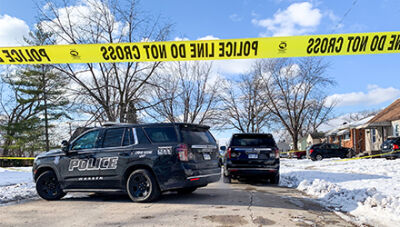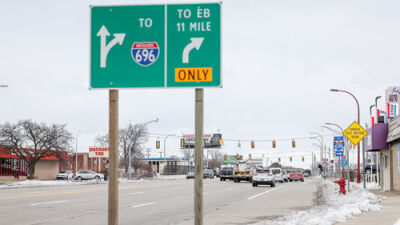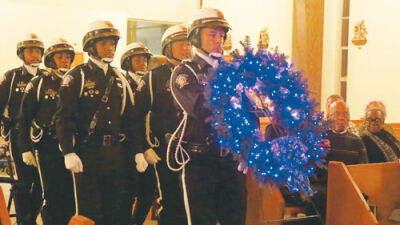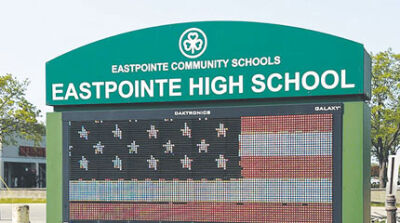
The infrastructure of Eastpointe High School is one of the subjects of the facilities master plan.
File photo by Patricia O’Blenes
EASTPOINTE — Eastpointe Community Schools officials are holding two input sessions this week to seek feedback from the community regarding the district’s master plan.
School officials have partnered with the strategic consulting firm Woolpert to provide an assessment of the district’s needs and to develop a comprehensive, long-term facilities plan.
Community members are invited to share their thoughts about the district’s future during an in-person input session from 4 to 6 p.m. April 17 at Eastpointe Middle School, 24701 Kelly Road.
For those who cannot attend Wednesday’s meeting, a virtual meeting is scheduled for 1-2:30 p.m April 19. Many Eastpointe Middle School and Eastpointe High School students have been selected to participate. A link for the virtual meeting will be posted on the district’s website at eastpointeschools.org, as will a QR Code, pictured.
The facilities plan is designed to address underutilized facilities, declining enrollment and annual facility budgets. The district has four elementary schools: Bellview and Pleasantview are grades 3-5 and Crescentwood and Forest Park are grades K-2.
The district’s Early Learning Center is where preschool programs are held. There also is Eastpointe Middle School, Eastpointe High School, the 8th Grade Academy, and Eastpointe Alternative Center & Virtual Academy.
At the March 25 Board of Education meeting, Woolpert presented five potential options for facilities master plans.
Option No. 1 includes three to four prekindergarten through grade 5 elementary schools and one 6-12 grade school.
Option No. 2 includes one early learning center, four K-5 elementary schools and one 6-12 school.
Option No. 3 includes three PK-5 elementary schools, one 6-8 middle school and one 9-12 high school.
Option No. 4 includes four PK-5 elementary schools, one 6-8 middle school and one 9-12 high school.
Option No. 5 includes one early learning center, four K-5 elementary schools, one 6-8 middle school and one 9-12 high school.
More information about the five options is available on the district’s website at eastpointeschools.org. Just click on the “strategic planning” headline.
Woolpert’s assessment of the district, combined with observations from Eastpointe Community Schools officials, has put an emphasis on addressing the high school’s infrastructure within the next five years. The high school building will turn 100 in 2029.
Representatives, too, will look at a surplus capacity across all the buildings in the district and will focus on maximizing the district’s $36.4 million bond issue that passed in August 2023.
‘Please get involved and have your voice heard.’
At the April 8 Board of Education meeting, Superintendent Christina Gibson encouraged the public to get involved with the input sessions. During her superintendent’s report, she also shared some initial staff feedback that school officials have received on the master plan.
“Just under 100 staff took time to give their initial reactions to the themes and the plans that were presented by Woolpert,” Gibson said.
The biggest areas were building renovation, grade consolidation and the status of Eastpointe High School.
“Many participants expressed a desire to see the high school renovated, citing the historical significance and potential. However, there were concerns about the cost of the project (with) some suggesting it would be more cost-efficient to build a new facility,” Gibson said.
“The state of the building was also a point of contention with some participants describing it as unsafe or in disrepair. There was also a suggestion to use parts of the high school for a community center,” Gibson said. “While there is this desire to preserve parts of the high school, there is also a recognition of the large financial and logistical challenge involved. Some participants felt the building was a waste of resources and should be closed, while others argued it’s a vital part of the district and should be kept open.”
Gibson also touched upon the possible grade consolidation as an option. She said the idea of consolidating grades 6 to 12 in one building was met with mixed reactions.
“Some participants saw it as sensible and cost-effective, while others expressed concerns about the age gap between the students and the potential behavior issues that could arise,” the superintendent said. “Despite concerns some participants felt this option made the most sense given our financial situation and service model.”
Another concern was trying to accommodate all the grade 6-12 students on one campus.
“The elementary buildings were well received by staff to move to the K-5 model,” Gibson said. “Participants appreciate the traditional structure and feel a K-5 model will benefit our students.”
The Early Learning Center was “a topic of significant discussion,” Gibson said. “Lots of participants felt strongly that it should stand alone due to licensing, while others questioned the necessity of keeping them separate.”
At the meeting, School Board President Jon Gruenberg encouraged residents to attend the input sessions.
“Please get involved and have your voice heard,” he said. “Show up for the input sessions.”
He also said the district is not unique in having declining enrollment.
“I was talking with another superintendent of another district recently, and they have seven elementaries. All of those elementaries are roughly at half capacity,” Gruenberg said. “Over the last two census cycles, I think the state of Michigan has actually lost students. School of Choice does kind of change it a bit. We’re all suffering from the overall loss of students in the state of Michigan.”
 Publication select ▼
Publication select ▼

